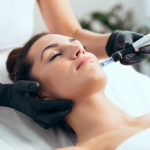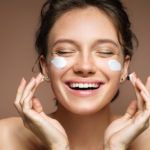Photo by Orawan Pattarawimonchai at Shutterstock
If you have ever stepped foot into a dermatologist’s office in Southlake, TX, you know there are a lot of creams and moisturizers out there. Most keep sample bags on their hands that they graciously hand out to their clients along with samples of products that they actually prescribe. Unlike other fields of medicine, dermatologists lean on a large array of products that are equally available over the counter and by prescription only. The very success of their practice hinges on knowing about every cream on the market and which one is the most effective for a large range of skin conditions.
Therefore, you might be surprised to learn what one of the most beloved moisturizers in a dermatologist’s arsenal is. It’s not what you are probably thinking, and it’s not a big name that you will recognize from the beauty store shelves or celebrity magazines. Instead, it’s a small jar that you probably only reach for when your lips get dry: petroleum jelly. Known by its brand name of Vaseline to most, it turns out that sometimes the simplest solutions are the most effective at fighting dry skin. This isn’t to say that you can skip the office in Southlake, TX, because some problems do truly require more sophisticated solutions, but don’t count out the effectiveness of Vaseline either.
History of Petroleum Jelly
Petroleum jelly is such an effective moisturizer, that it was actually created with the intention of using it to treat leather in 1867. However, the world of medicine saw how easily it was able to replenish leather and quickly grabbed ahold of the product for use treating dry hair and chapped hands which were common in those days. Prior to the invention of vaseline, lard was the substance of choice for dry skin, but the quick moisturizing (and better smelling) jelly quickly took over.
Not the Same as Petrolatum
Despite the name, it is important to note that petroleum jelly is not the same as industrial-grade petroleum. No dermatologist would dare use this type of petroleum given it would destroy the skin and likely cause a number of reactions. However, what is placed in topical products is completely safe for almost everyone and is not associated with any skin reactions. Petroleum jelly is non-allergenic, regulated, odorless, and comedogenic which is one of the many reasons that it is a favorite among so many dermatologists around the world.
Petroleum Jelly as a Moisturizer
Unlike a lot of moisturizers that are heavy or expensive, petroleum jelly is always available and it is accessible to every client regardless of their financial situation. This makes it a great option for dermatologists who prefer to stick with solutions that are familiar to their clientele. However, affordability is not the only reason why petroleum jelly is a favorite, the fact that it works so effectively is by far the biggest reason.
As an occlusive, petroleum jelly is extremely effective. In fact, it is able to reduce as much as 99% of all water loss when applied to the skin because it penetrates down through the stratum corneum and stimulates the skin barrier to start repairing itself. At the same time it is stimulating skin revival, it is also softening skin which makes it dual-purposeful as an emollient and an occlusive. The benefits don’t stop there, as it can be used on both inflamed and healthy skin so there really is no time or situation where it is not appropriate to use.
How to Use Petroleum Jelly
You should never use this advice to replace the advice of a properly trained dermatologist. Everyone has different skin and there are many skin conditions that require attention from a professional. If you suffer from a skin disease you probably already know this all too well, but all of that said, there are some simple ways you can use petroleum jelly that you probably have never thought about. Instead of buying some expensive lotion at the store while you wait for your next visit, you might want to consider grabbing a jar of vaseline and treating some common issues in a much more effective manner.
Moisturizer
To start, petroleum jelly is great for use as a moisturizer. It is great to use on areas of your skin that look rough or patchy or to treat dry flaky areas of the skin. You also can use petroleum jelly to treat cracks and hardened skin on the heels of your feet. However, it should be noted that the heel of the foot is some of the roughest skin to treat, so if you don’t have any luck you don’t want to put off calling the dermatologist for help.
Lips
Unless you have a skin condition that doesn’t respond to normal treatment, petroleum jelly is one of the best things you can purchase to treat chapped lips. In fact, it is the base of almost every type of chapstick for good reason- because it works.
Wounds and Cuts
While petroleum jelly might not be the first thing you reach for when you get a cut, it can actually help a wound heal faster. This is one reason why you will often see it as an ingredient inside of antibiotic ointments. However, it should not be used to clean wounds as it doesn’t have any antiseptic qualities.
Diaper Cream
Petroleum jelly is safe enough that it can be used on infant skin in sensitive locations. Diaper rash is not fun for anyone but can be prevented if you use petroleum jelly as a barrier ointment that you cover the skin folds with between diapers.
If you are having skin issues that won’t resolve, it is time to consult a professional dermatologist in Southlake, TX. Compassion Dermatology treats an array of clients with a variety of different skin conditions and would be happy to help you restore your skin to its best condition.


